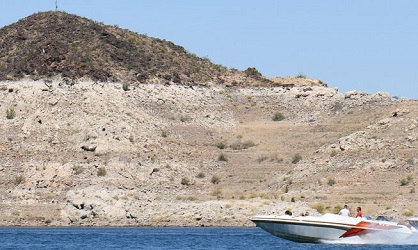LAS VEGAS—Nevada Gov. Steve Sisolak has signed into law a bill supported by the Southern Nevada Water Authority that requires the removal of “useless,” or purely decorative, grass throughout the Las Vegas Valley by the end of 2026. The Valley has been undergoing a severe drought as indicated by the U.S. Drought Monitor.
The law does not apply to grass in homeowners’ yards, or to grass used for recreation at schools and parks.
Useless grass, also known as nonfunctional turf, is found around Southern Nevada business complexes (including hotels and resorts), along streets in HOA communities, and in traffic circles and medians. It is grass that provides no recreational value.
Nonfunctional turf is grass that no one uses for sports, picnics, or other recreational activities. Some areas of nonfunctional turf are simply narrow strips grass bordering parking lots, walkways, and sidewalks. These narrow areas of purely decorative grass create significant amounts of sprinkler overspray and water waste.
Landscaping at Commercial Properties
Other examples of nonfunctional turf are found along streets between the curb and sidewalk; in traffic circles and medians; in landscaping at office parks and commercial properties, and at entryways for housing developments.
If the only person that uses the grass is pushing a lawn mower, it is nonfunctional.
It is estimated that there are approximately 5,000 acres of nonfunctional turf throughout Southern Nevada. The unused grass in the Las Vegas Valley soaks up about 12 billion gallons of water every year. That is equal to more than 10 percent of the Valley’s entire allocation of water from the Colorado River—the main source of Southern Nevada’s drinking water. Replacing this water-thirsty grass with desert-friendly plants would save the community about 9.5 billion gallons per year.

Water is a limited resource in the Las Vegas Valley, so conservation is a priority for everyone who lives there. Water levels at Lake Mead are projected to drop to historic lows in 2021 due to ongoing drought conditions. On Thursday, June 10, the U.S. Bureau of Reclamation announced that Lake Mead officially fell to its lowest level since it was first filled following the completion of the Hoover Dam in 1936. Lake Mead is defined as “full” when the water line reaches an elevation of 1,221.4 feet above sea level. It currently rests at 1,071.53 feet above sea level, at 36 percent capacity. This will cause the federal government to declare the first-ever water shortage along the Colorado River, resulting in a reduction to Nevada’s water allocation by about 7 billion gallons.
Time Allowed for Adjustments
The legislation prohibits the use of Colorado River water to irrigate the nearly 4,000 acres of nonfunctional turf on properties that are not zoned exclusively for single-family residences after January 1, 2027. It calls for the formation of a Nonfunctional Turf Removal Advisory Committee to provide community input and feedback from stakeholders affected by the proposal. The five-year timeline between the legislation’s passage and the deadline for turf removal will ensure the community can transition to water efficient landscaping with opportunities for community input and feedback.
Resorts consume about 4 percent of the Las Vegas community’s water supply—that is the water that is only used once and not recycled. In addition, new resorts are required to submit water efficiency plans to encourage efficient water management practices. Viewed from the state level, the resort sector uses less than one-half of one percent of the Nevada’s water supply, while employing about 21 percent of the state’s workforce.
To date MGM Resorts International has converted over 200,000 square feet of real grass to artificial turf or desert-friendly landscape to help reduce its consumptive water use (water it does not send back to the source).
It is a common misperception that golf courses (along with resorts) use large amounts of the community’s water, primarily due to the high visibility of these sectors. In reality, golf courses use about 6 percent of the area’s water, compared to the 60 percent used by residents.






